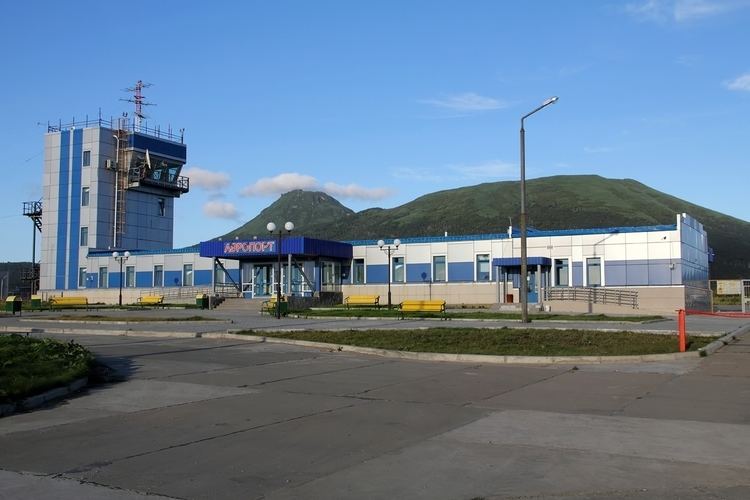Area 1,856 km² | ||
 | ||
Urban okrug Yuzhno-Kurilsky Urban Okrug Administrative center of Yuzhno-Kurilsky Urban Okrug | ||
Yuzhno-Kurilsk (Russian: Ю́жно-Кури́льск) is an urban locality (an urban-type settlement) and the administrative center of Yuzhno-Kurilsky District of Sakhalin Oblast, Russia. Population: 5,832 (2010 Census); 5,751 (2002 Census); 6,344 (1989 Census). It is the largest settlement on the Kunashir Island of the Kuril Islands.
Contents
Map of Yuzhno-Kurilsk 694500
History
The history of Yuzhno-Kurilsk is connected with the history of the Kuril Islands as a whole. In Russia, the Kuril Islands first became known after an expedition by Russian explorer Ivan Moskvitin and his companions, after which another explorer Kolobov in 1646 talked of the Ainus—the indigenous inhabitants of the Kuriles. According to some Japanese sources, Kunashir became known to Russians later than the other islands of the Kuril chain.
After that, the Kuriles, Sakhalin, and Hokkaido were explored and settled both by the Russians and Japanese. By the end of the 18th century, first settlements of Russian exiles and volunteers appeared on the Kuriles. Also, along with Ainu settlements, the islands had a Japanese trading post and fortified settlements with military garrisons. In 1769, Lieutenant Ivan Chyorny was informed that the Japanese on Kunashir had founded a settlement with a fortress and a permanent garrison.
Weakened by the Crimean War, in 1855 Russia signed the Simodsky treaty and ceded a part of the South Kuril Islands to Japan, including the island of Kunashir. The Japanese predecessor of Yuzhno-Kurilsk, the village of Furukamappu (Japanese: Furukamappu (古釜布)), was located in the northeastern corner of the eponymous bay. Furukamappu with the neighboring villages of Okinokotan and Isoyanbetsu had fifty houses. There was a post office with the telegraph and shops. When the island was administered by Japan (1855–1945), other settlements were founded as well.
Kunashir came back under the Russian rule on September 1, 1945 as a result of the Kuril landing operation. A Platoon of the Machine Gun Battalion of the 113th Infantry Brigade of the 87th Infantry Corps of the 2nd Far Eastern Front landed near Furukamappu. On the shore there was a Japanese battalion commander waiting for them with a white flag in hands. The Japanese garrison surrendered without a fight. On February 2, 1946 the island was included in the Yuzhno-Sakhalinsk (Sakhalin) Oblast of the USSR, and the village of Yuzhno-Kurilsk was founded. The first Yuzhno-Kurilsk City Council and all the services of civil authority were formed from members of the 113th Infantry Brigade. Captain Babukhadiya, an artillery division battery commander, became the first chairman of the regional executive committee.
After World War II, active construction was launched using Soviet military forces. Japanese prisoners of war who were kept on Kunashir in a separate camp were also used for the construction. Japanese prisoners of war were given the same rations as Soviet soldiers. The Japanese wore their uniform with their own insignia, were divided into platoons and companies with their commanders in the lead. They moved around in formation, abode by strict discipline and order according to the statutes of the Japanese army (if it posed no harm to the Soviet side).
According to the decision of the Soviet Government, in the summer of 1947 all the Japanese people were repatriated from the Kuril Islands to Hokkaido, Japan. By that time Kunashir was settled by many immigrants and seasonal workers from various regions of the Soviet Union. Fisheries based on Kunashir and Shikotan began to increase their production output and revenues.
After the 1953 tsunami, many Yuzhno-Kurilsk public facilities had to be rebuilt 30 meters (98 ft) above the previous level. After the 1994 earthquake in the open sea to the east of the island of Hokkaido, the buildings sustained extensive damage and were rebuilt at a new location.
After a period of uncertainty and decline in the 1990s, largely caused by the fears that the island was going to be ceded to Japan, Yuzhno-Kurilsk gradually began to revive. A Federal Program for the Development of the Kuril Islands involves a significant investment to build a new airport, roads and other facilities on the island.
Administrative and municipal status
Within the framework of administrative divisions, Yuzhno-Kurilsk serves as the administrative center of Yuzhno-Kurilsky District and is subordinated to it. As a municipal division, the urban-type settlement of Yuzhno-Kurilsk and nine rural localities of Yuzhno-Kurilsky District are incorporated as Yuzhno-Kurilsky Urban Okrug.
Climate
Yuzhno-Kurilsk has a borderline humid continental climate (Köppen Dfb) that is almost cold enough in the warmest months to be a subarctic climate. Precipitation, however, is much heavier than most climates of its type owing to the presence of strong onshore winds from the Pacific Ocean. These, however, make the whole archipelago extremely cloudy, especially in the summer when fog from the Oyashio Current produces near-saturation humidity and extremely high cloudiness. However, Yuzhno-Kurilsk itself is less affected than places to the north because it is somewhat shielded from fog by the Shiretoko and Nemuro Peninsulas and actually receives more sunshine than Wakkanai and only marginally less than Sapporo.
Maritime influences are also reflected in summer temperatures being much lower than in comparable latitudes in the interior of Asia; for example, the warmest month at Yuzhno-Kurilsk is 5 °C (9.0 °F) cooler than at Vladivostok and 9 °C (16 °F) cooler than in Harbin. Due to its less cold winters, these differences even out during the course of the year, but Yuzhno-Kurilsk has a 10 °C (18 °F) colder climate annually than Genoa, Italy on the exact latitude.
The climate in this part of the world is at a huge anomaly in respect to latitude, with an exceptionally cold climate for a marine area nearer the tropics than the polar zone.
Transport
SAT airlines operates flights to and from Yuzhno-Sakhalinsk 3 times per week, out of Mendeleyevo Airport (ICAO: UHSM), located 20 kilometers outside Yuzhno-Kurilsk. One or two times every month in summer, there is a ferry service connecting to Korsakov on Sakhalin island.
